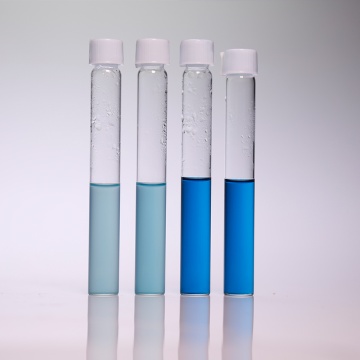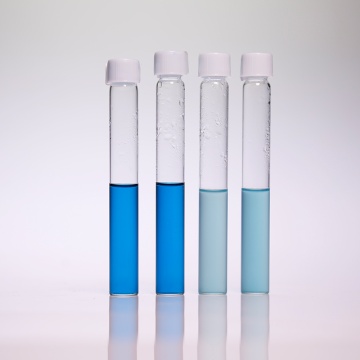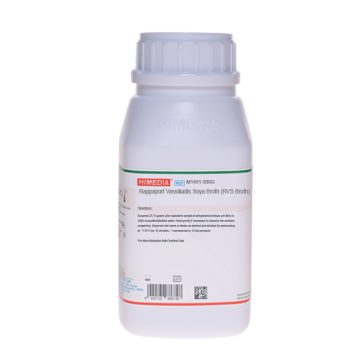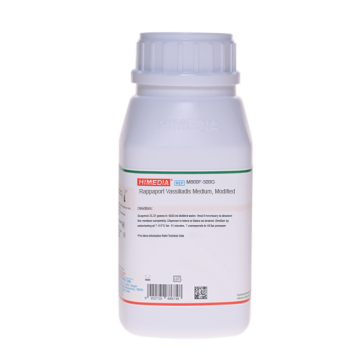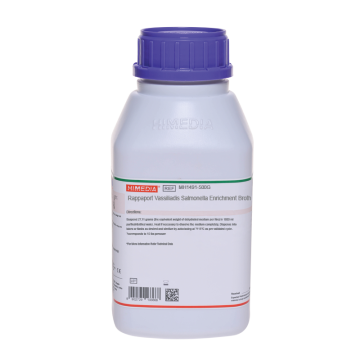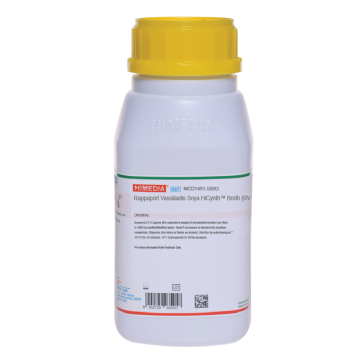 Your enquiry has been submitted
Your enquiry has been submitted
Rappaport Vassiliadis R10 Medium
Selective Enrichment#CC293D
Intended Use
Recommended for selectively enriching Salmonella species from meat and dairy products, faeces and sewage polluted water.
Composition**
| Ingredients | g / L |
|---|---|
| Tryptone | 4.540 |
| Sodium chloride | 7.200 |
| Potassium dihydrogen phosphate | 1.450 |
| Magnesium chloride | 13.400 |
| Malachite green oxalate | 0.036 |
| Final pH ( at 25°C) | 5.1±0.2 |
**Formula adjusted, standardized to suit performance parameters
Directions
Suspend 26.62 grams in 1000 ml purified/distilled water. Heat if necessary to dissolve the medium completely. Dispense in tubes or flasks as desired. Sterilize by autoclaving at 15 lbs pressure (121°) for 15 minutes.
Principle And Interpretation
Rappaport Vassiliadis R10 Broth is a selective enrichment medium that is used following pre-enrichment of the specimen in a suitable pre-enrichment medium. It has gained approval for use in analyzing milk and milk products (1), raw flesh foods, highly contaminated foods and animal feeds (2). Rappaport et al (3) formulated an enrichment medium for Salmonella that was modified by Vassiliadis et al (4). The Vassiliadis modification, designated R10/43°C, had a reduced level of malachite green and recommended incubation at 43°C. Later work by Peterz showed that incubation at 41.5 ± 0.5°C for 24 hours improved recovery of Salmonella species (5). Rappaport Vassiliadis R10 Broth medium selectively enriches for salmonellae because bacteria, including other intestinal bacteria, are typically resistant to or inhibited by malachite green, high osmotic pressure and/or low pH. S. Typhi and S.Choleraesuis are sensitive to malachite green and may be inhibited. The medium contains tryptone which provides essential growth nutrients. Magnesium chloride raises the osmotic pressure in the medium. Malachite green is inhibitory to organisms other than Salmonellae. The low pH of the medium, combined with the presence of malachite green and magnesium chloride, helps to select for the highly resistant Salmonella species. Potassium phosphate buffers the medium to maintain the constant pH. Sodium chloride maintains the osmotic balance.
Type of specimen
Clinical samples: faeces; Food and Dairy Samples; Water Samples
Specimen Collection and Handling
For clinical samples follow appropriate techniques for handling specimens as per established guidelines (6,7).
For food and dairy samples, follow appropriate techniques for sample collection and processing as per guidelines (8,9,10).
For water samples, follow appropriate techniques for sample collection, processing as per guidelines and local standards (11).
After use, contaminated materials must be sterilized by autoclaving before discarding.
Warning and Precautions
In Vitro diagnostic use. For professional use only. Read the label before opening the container. Wear protective gloves/protective clothing/eye protection/ face protection. Follow good microbiological lab practices while handling specimens and culture. Standard precautions as per established guidelines should be followed while handling clinical specimens. Safety guidelines may be referred in individual safety data sheets.
Limitations
- Overheating may destroy the selectivity of medium.
Performance and Evaluation
Performance of the medium is expected when used as per the direction on the label within the expiry period when stored at recommended temperature.
Quality Control
Appearance Light yellow to light blue homogeneous free flowing powder
Colour and Clarity of prepared medium Greenish blue coloured clear to slightly opalescent solution that may have precipitate.
Reaction Reaction of 2.66% w/v aqueous solution at 25°C. pH : 5.1±0.2
pH 4.90-5.30
Cultural Response Cultural characteristics observed after an incubation at 42 - 43°C for 18-24 hours. After incubation, subculture on selective agar media like MacConkey Agar (M081) or XLD Agar (M031) and incubate at 35-37°C for 18-24 hours.
| Organism | Inoculum (CFU) | Growth at 42±1°C | Recovery | Colour of colony |
|---|---|---|---|---|
| Escherichia coli ATCC 25922 (00013*) | 50-100 | none-poor | <=10% | pink-red |
| Salmonella Enteritidis ATCC 13076 (00030*) | 50-100 | good-luxuriant | >=50% | colourless |
| Salmonella Typhimurium ATCC 14028 (00031*) | 50-100 | good-luxuriant | >=50% | colourless |
Key : *Corresponding WDCM numbers.
Storage and Shelf Life
Store between 10-30°C in a tightly closed container and the prepared medium at 15-30°C. Use before expiry date on the label. On opening, product should be properly stored dry, after tightly capping the bottle in order to prevent lump formation due to the hygroscopic nature of the product. Improper storage of the product may lead to lump formation. Store in dry ventilated area protected from extremes of temperature and sources of ignition. Seal the container tightly after use. Product performance is best if used within stated expiry period.
Disposal
User must ensure safe disposal by autoclaving and/or incineration of used or unusable preparations of this product. Follow established laboratory procedures in disposing of infectious materials and material that comes into contact with clinical sample must be decontaminated and disposed of in accordance with current laboratory techniques (6,7).
Reference
- International Dairy Federation, 1995, Milk and Milk Products: Detection of Salmonella, IDF Standard 93B:1005. Brussels, Belgium.
- Horwitz, (Ed.), 2000, Official Methods of Analysis of AOAC International, 17th Ed., AOAC International, Gaithersburg, Md.
- Rappaport F., Konforti N. and Navon B., 1956, J. Clin. Pathol., 9, 261-266
- Vassiliadis P., Trichopoulos D., Kalandidi A. and Xirouchaki E., 1978, J. Appl. Bacteriol., 44:233.
- Peterz M., Wiberg C. and Norberg P., 1989, J. Appl. Bacteriol., 66,523-528.
- Isenberg, H.D. Clinical Microbiology Procedures Handbook 2nd Edition.
- Jorgensen, J.H., Pfaller, M.A., Carroll, K.C., Funke, G., Landry, M.L., Richter, S.S and Warnock., D.W. (2015) Manual of Clinical Microbiology, 11th Edition. Vol. 1.
- American Public Health Association, Standard Methods for the Examination of Dairy Products, 1978, 14th Ed., Washington D.C.
- Salfinger Y., and Tortorello M.L., 2015, Compendium of Methods for the Microbiological Examination of Foods, 5th Ed., American Public Health Association, Washington, D.C.
- Wehr H. M. and Frank J. H., 2004, Standard Methods for the Microbiological Examination of Dairy Products, 17th Ed.,APHA Inc., Washington, D.C.
- Lipps WC, Braun-Howland EB, Baxter TE,eds. Standard methods for the Examination of Water and Wastewater, 24th ed. Washington DC:APHA Press; 2023.
| Product Name | Rappaport Vassiliadis R10 Medium |
|---|---|
| SKU | M1530 |
| Product Type | Regular |
| Physical Form | Powder |
| Origin | Animal |
| Packaging type | HDPE |
| References | 1. Horwitz, (Ed.), 2000, Official Methods of Analysis of AOAC International, 17th Ed., AOAC International, Gaithersburg, Md. |
| Customized Product Available | No |




